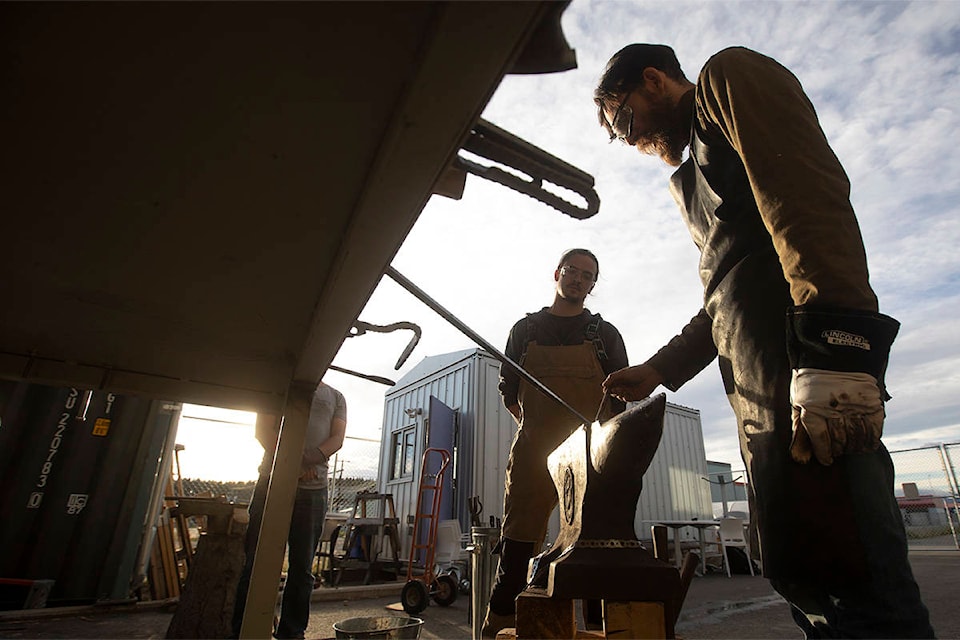It’s hard work, it’s hot work and these days more art than necessity — but blacksmithing in Whitehorse is generating propane-fuelled creativity.
On Sept. 8 aspiring smithies signed up for a workshop on using Yukonstruct’s new gas forge and tried their hand at shaping steel rods into rugged fire pokers.
Instructor Jonathon Driscoll started blacksmithing as a teenager growing up in Prince Edward Island. An interest in historical reenactments and vikings led him to track down parts for an old coal-heated blacksmith forge in the yard and picking up an anvil at an auction.
“Then for a few years, I had made random viking parts and cooking gear. Either for myself or I sold a bit of it at festivals,” he said.
The interest waned as Driscoll traveled and moved to cities across Canada, without space for a shop or setup.
“So when I came here, and I heard that they had a forge at the Makerspace, I started using it and at that point, nobody was giving a workshop on it. So I kind of picked up where I had left off more than 10 years ago. I read all the books and visited blacksmiths and picked up some things from YouTube and refreshed a little bit. I want to get more people in to use the equipment,” he said.
Yukonstruct has two types of blacksmithing forges. The original is a small induction forge, which uses electricity and hot coils to heat up metal for forming. On Sept. 8 the new gas forge, a small insulated oven-like setup that runs on propane, made its debut.
“The induction forge is super efficient, so it costs barely anything. But if I want to heat up the whole length of a three-foot-long fire poker to put a nice beautiful long twist in it, I have to go back and heat up different sections of it. On the gas forge, I could put like 15 fire pokers in. For doing larger pieces that don’t fit in the induction forge or to heat up a much larger section of steel, then there’s a big advantage with the gas for that,” Driscoll said.
At the evening workshop, steel rods destined to become fire pokers go into the forge to heat up. The flames licking the entrance of the hot forge are called “dragon’s breath.”
Once the section of steel for shaping has become red-orange hot, the bars are removed with a gloved hand and placed on an anvil for hammering, twisting, cutting and bending.
“You have to think about what you want to do, because the second you take it out it’s getting cold,” Driscoll instructs as the workshop’s two participants begin hammer swings.
The sound of steel on steel fills the yard until the metal no longer yields and needs to go back into the forge.
“Welding is very practical, you get to stick stuff together, whereas blacksmithing you kind of get to shape it the way you need. It’s kind of easy to get started in welding, you can get a pretty cheap welding machine anywhere. You can’t just pick up a forge at Canadian Tire for $100, it’s more of a rare skill,” said workshop participant Marc Côté.
Côté compares shaping the metal to clay. Unlike clay, it’s extremely hot work. Gas and induction forges often heat metals to around 1,200 C, and burns are the biggest safety hazard when working.
Steel tools made by Driscoll help shape the metal with tongs and bars to add decorative twists and functional bends. The shape of the anvil is used strategically to curve and flatten the hot steel.
“You’re swinging a hammer, but it’s not like driving nails in. It’s a little harder on the arms than you would expect. It’s a lot harder. I work with tools every day but I was still kind of surprised,” Côté said.
When the fire pokers are finished, they’re placed in cool water buckets for a satisfying sizzle.
Côté plans to use his new skills to design specialized axe heads, while Driscoll has previously made rugged tools, plant hangers, bottle openers, armour and knives.
Driscoll said a wide range of people have attended the blacksmithing workshop — some curious about entering the trade or taking a longer course elsewhere, and some just want to explore a new hobby.
Once upon a time, blacksmithing was a critical trade in towns across Canada. Plenty of evidence can be found around the territory of forged tools. Among other functions, smiths repaired tools and shoed horses, reshaping metal to extend the lifespan or purpose of valuable material.
The industrial revolution slowly phased out a lot of blacksmithing, which was replaced by machinists and factory-made metal parts during the 1800s and 1900s. While professional uses still exist, the majority of smiths today pursue the trade artistically.
The trade saw a renewed interest in the ‘70s, according to the Artist-Blacksmith’s Association of North America, which promotes “the noble art of blacksmithing” as a heritage pursuit and unique aesthetic. The association now has 4,000 members.
Shaping and working the metal takes finesse. Different parts of the hammer, the anvil and the angle of the strike can all make a difference in the final goal.
“Hammer control comes with time and practise,” Driscoll said.
“It’s not everybody’s thing. But for me, the parts I really like is that it requires focus and problem-solving. You need to work somewhat three-dimensionally because you’ve got this piece of metal, but it’s mentally calculating and pretty intuitive,” he said. “It’s really satisfying to go from a scrap from a transfer station that somebody’s throwing away, and then all of a sudden what used to be a spring from a garage door opener is now a garden tool, a plant hanger or a handle.”
Contact Haley Ritchie at haley.ritchie@yukon-news.com
